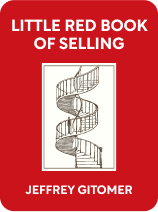

This article is an excerpt from the Shortform book guide to "Little Red Book of Selling" by Jeffrey Gitomer. Shortform has the world's best summaries and analyses of books you should be reading.
Like this article? Sign up for a free trial here .
Do you work in high-profile sales? What can you do to level up your sales game?
Jeffrey Gitomer, the author of several best-selling books on sales, argues that to be successful at sales, you must first create an atmosphere conducive to buying. To this end, you must first prepare by doing your research on the prospect’s business. Once you understand their needs, try to secure a meeting with the top decision-maker in the company. And after getting in front of the person who can say “yes” to a sale, the next step is to give value.
Here are some tips on how to be successful at sales, according to sales trainer Jeffrey Gitomer.
Level Up Your Sales Game
If you want to learn how to be successful at sales, Jeffrey Gitomer’s literature is a great place to start. Gitomer, a sales trainer and the author of numerous best-selling books on sales, argues that to become a successful salesperson, you must take a long-term view of sales rather than focusing on making quick sales to meet your end-of-month goals. He is a firm believer in playing the long-game approach to every high-profile sale. This entails three steps: preparing in advance, selling to the top decision-maker, and giving value.
Prepare in Advance
Too many salespeople walk into sales calls without having done any research on the prospect’s business. Then they ask the prospect, “Tell me about your business,” which irritates her and wastes her time. They follow up with, “Let me tell you about my business,” which the client couldn’t care less about. Then, when they fail to sell their product or service, they complain about the challenges of selling.
Instead of complaining that sales is hard, work harder to prepare. Start your workday the night before by planning what you’ll focus on, then get to work early each day so you can start selling immediately rather than spending half your day getting ready to sell.
As part of your planning, do your homework on the prospect’s business by:
- Searching the internet and business databases for news and information about the company
- Studying the company’s website and literature, such as annual reports and marketing materials
- Talking to the company’s customers and vendors
- Talking to competitors
- Consulting with people in your network who know the company
- Talking with company employees, especially salespeople who know the internal workings and like to talk
While you’re at it, Google your own name to see what the prospect will see if she looks you up.
Serious preparation takes time and effort but impresses the client by demonstrating your diligence and interest in her company—and you can spend your time with them asking useful questions rather than questions you should already know the answers to. Further, if you don’t prepare, you’ll lose sales to competitors who do prepare.
Meet With the Top Decision-Maker
After you’ve prepared by doing your research, the next selling principle is getting a high-level meeting. You need a face-to-face appointment with the real decision-maker, not an underling—or you won’t sell anything. Underlings, who need to get additional approvals before agreeing to a sale, won’t prioritize your case or present it as well as you do, so any time you spend with them is wasted.
If you’re stuck at first with a middle manager, try to get an additional meeting with the boss. If the middle manager says, “Everything looks good, I just need the CEO’s approval,” your response should be, “Fine, when can we meet with her?” If the underling doesn’t agree:
- Confirm the lower-level manager’s personal approval.
- Talk in terms of “we” and “the team” to create a feeling of alliance on the manager’s part.
- Take the initiative to set up a meeting with all decision-makers; make sure you know the key decision-maker in advance. While the manager may resist this approach, if you don’t insist, you’ll lose the sale.
- Make your presentation again, this time to everyone involved.
To avoid having to circumvent a lower-level manager in the first place, ensure that you’re talking to the real decision-maker by asking:
- Do you work with anyone else in making decisions like this?
- How will this decision be made? With each step that’s mentioned, ask, “Then what do you do?” until you drill down to the final decision-maker, with whom you’ll want to schedule a future meeting.
Get Past the Gatekeeper or Voicemail
Once you’ve determined who the top-decision maker is, you’ll have to get past the gatekeeper or ensure you get a callback from your voicemail message. If you get stuck at one of those points, you need to:
- Take a different approach: Visit the company and ask to speak to someone in sales. A salesperson will show up within minutes, hoping to make a sale. As a fellow salesperson, create rapport, then ask them how to connect with the CEO.
- Improve your skills: Leave a better voicemail message that differentiates you by using humor or creativity and gives the prospect a compelling reason to call you back and arrange a meeting.
Give the Decision-Maker a Compelling Reason to Meet With You
As explained in Part 2, branding and networking can help you get past gatekeepers—if the CEO has met or heard of you, she’s more likely to take your call. But you still need to sell the prospect on agreeing to a face-to-face meeting with you.
When your call is put through, the first thing you must do is engage with the prospect—that is, get his attention by piquing his interest. Statements everyone uses that don’t engage include:
- How are you today?
- Have you ever heard of us?
- May I have five minutes of your time?
- Would you like to save money on X?
Prospects don’t want to hear about you or be educated by you. Instead, address your prospect’s greatest interests: profit and productivity. Tell the prospect you want to discuss how you can increase his profitability, and he’ll see value in meeting with you.
Give Value
Most salespeople have the wrong idea about value. They think of value as a small extra that’s added to the product—for example, a discount or something free. But your competitors can match these things, so they don’t increase your chances of making a sale. They’re promotions, not value. Value is something you give that’s meaningful to the customer—for instance, increased productivity, profit, and sales; more customers; a better image; and so on.
Giving value is twofold: You give value to people personally, and your product provides value. Giving value personally might take the form of sharing your expertise or offering business-building tips in a free emailed newsletter, and using your network to connect people who can help each other.
In the selling process, you must focus on the value of your product to the customer, which is their chief interest. (Remember from the introduction to this book that perceived value is one of the key reasons why customers buy.) In addition to increased productivity and profit, focus on the use and value of the product over its lifetime. Get the prospect to think about what her life will be like after buying the product.
The more compelling your value proposition, the less important price becomes. If the customer is focused on price, it means you haven’t adequately addressed value.
Instead of focusing on making your sales quota, focus on articulating and delivering value—and you’ll make each sale and earn a commission. You’ll also build valuable relationships, which over the long term, will earn you a fortune, both in friendship and ongoing sales.

———End of Preview———
Like what you just read? Read the rest of the world's best book summary and analysis of Jeffrey Gitomer's "Little Red Book of Selling" at Shortform .
Here's what you'll find in our full Little Red Book of Selling summary :
- Jeffrey Gitomer’s 13 principles of selling
- How to eliminate hurdles and win more sales
- The reasons why people buy even though they don't like being sold to






